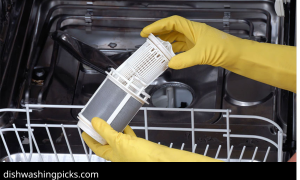Let’s paint a picture: after countless cycles of washing, that filter responsible for catching debris, food particles, and grime has been quietly doing its job. It’s kept your dishes spotless, but in return, it has become burdened and clogged with the remnants of your culinary adventures. That’s where our journey begins on how to clean filter on KitchenAid dishwasher.
How to clean filter on kitchenaid dishwasher
it’s an act of compassion for the faithful appliance that has made your kitchen life easier.
In the following paragraphs, we’ll explore the step-by-step process to ensure that your dishwasher’s filter is maintained, extending its life, and ensuring it continues to serve you efficiently.
It’s a small yet significant gesture of care for the unsung hero inside your dishwasher.
The Importance of a Clean Dishwasher Filter

Imagine this: You’ve just enjoyed a delicious home-cooked meal with your family. The table is cleared, and the dishes are stacked, ready to take on the task of cleaning up.
It’s a comforting sight, a glimpse of the convenience that modern appliances bring to our lives.
But have you ever considered what makes this dishwasher work its magic so effectively? It’s the unsung hero hidden inside the filte.
The dishwasher filter’s job is to capture food debris, grease, and particles, ensuring they don’t recirculate onto your dishes during the cleaning process. It’s a workhorse that toils silently, keeping your dishes spotless.
Best drinking glasses for dishwasher (Best 7 suggestions)
Explanation of the types of filters in KitchenAid dishwashers
Before we dive into the steps of how to clean filters on a KitchenAid, dishwasher it’s essential to understand the different types of filters you might encounter in a KitchenAid dishwasher. Each plays a vital role in ensuring your dishes come out sparkling clean. Let’s take a closer look.
The coarse filter is the first line of defense in your dishwasher. Its job is to capture larger particles, such as food scraps and debris, preventing them from clogging the inner workings of your appliance. It’s like the gatekeeper, intercepting the big stuff and making sure it doesn’t interfere with the washing process.
Sitting beneath the coarse filter, the fine filter is designed to catch smaller particles and residues; it’s like a diligent detective, capturing tiny remnants of food and grease that the coarse filter might have missed.
The fine filter ensures that only clean water circulates during the washing cycle, so your dishes receive the thorough cleaning they deserve.
Micro-Filtration System (Optional)

Some KitchenAid dishwashers feature a micro-filtration system, an advanced filter designed to trap even finer particles, providing an extra level of cleanliness. It’s like the final piece of the puzzle, ensuring that the water used in the washing cycle is as pure as possible.
Filters in dishwashing efficiency
Understanding these types of filters is the first step in maintaining your dishwasher’s efficiency. With this knowledge, you’ll be better equipped to care for your appliance, ensuring that it continues to deliver spotless dishes, meal after meal.
It’s a practical insight that contributes to the longevity of your kitchen companion and a more convenient, cleaner, and compassionate kitchen:
The Role of Filters in Dishwashing Efficiency
Picture this: It’s the end of a delightful dinner party, how to clean filter on KitchenAid dishwasher ready to tackle a mountain of dirty dishes. As you load the dishwasher and press the start button, a series of events unfolds behind the scenes, guided by a silent hero—the filters:
Capturing Food Debris
The coarse filter, the first line of defense, springs into action. It’s akin to a diligent gatekeeper at the entrance, capturing large particles like bits of food and debris. Imagine it as the friendly host who ensures only the guests are allowed inside, while the clutter stays out.
Best and most effective dishwasher detergent for grease ever
Fine-Tuning the Clean
Beneath the coarse filter, the fine filter takes over. Like a meticulous detective, it’s on the lookout for smaller particles and residues that may have slipped past the first filter.
It ensures that the water used in the cleaning process is as clean as possible, leaving your dishes spotless. It’s the filter that goes the extra mile, much like a devoted housekeeper who leaves no corner untouched.
Where is the filter on my KitchenAid?
The location of the filter in a KitchenAid dishwasher can vary depending on the specific model and year of manufacture. However, in most KitchenAid dishwashers, the filter is typically found at the bottom of the dishwasher, near the lower spray arm. Here are the general steps to locate and access the filter:
- To access the lower dish rack, open the dishwasher door and slide it out. Remove any dishes or utensils from the rack to access the filter.
- Look for a round or rectangular filter assembly at the bottom of the dishwasher tub. It’s usually situated near the back, just below the lower spray arm.
- The filter assembly may have a central cylindrical filter, a fine mesh screen, and a coarse filter. The exact design can vary, but it will typically be made up of multiple components.
- To access the filter for cleaning, you may need to turn it counterclockwise to unlock it or simply lift it out of its housing, depending on the specific design.
- Once you’ve removed the filter assembly, you can clean it by rinsing it under running water. You may also need to use a soft brush or toothbrush to scrub away any stubborn debris.
- After cleaning, reinsert the filter assembly into its original position and secure it. Make sure it is properly locked or secured in place.
Keep in mind that the design and location of the filter may vary from one KitchenAid dishwasher model to another, so it’s a good idea to consult your dishwasher’s user manual for model-specific instructions on how to locate and clean the filter. If you don’t have the manual, you can often find it on the KitchenAid website or by contacting KitchenAid customer support.
Choosing the Best Air Gap for Dishwasher
Where is the filter on a KitchenAid?
The location of the filter on a KitchenAid appliance can vary depending on the specific model and type of appliance you are referring to. KitchenAid manufactures a wide range of appliances, including refrigerators, dishwashers, and coffee makers, all of which may have filters.
To help you in finding the filter on your KitchenAid appliance, I’ll provide a general overview of where filters are typically located in some common KitchenAid appliances:
Most KitchenAid refrigerators have water and ice dispensers that use filters to improve water quality and taste. The water filter is usually located inside the refrigerator compartment or at the bottom grille of the refrigerator. Look for a filter compartment or cartridge that you can easily access and replace. Refer to your refrigerator’s user manual for specific instructions on changing the water filter.
Some KitchenAid dishwashers have filters to capture food particles and debris to keep your dishes clean. Depending on the model, the filter may be removable for cleaning. Again, consult your dishwasher’s user manual for details.
If you have a KitchenAid coffee maker, it may have a water filter. The filter is typically placed inside the water reservoir or in a designated filter compartment. This filter helps to purify the water used for brewing. Check your coffee maker’s manual for specific filter instructions.
Remember, the specific location and type of filter can vary between KitchenAid models, so it’s essential to consult the user manual that came with your appliance to find the exact location and replacement instructions for the filter. If you no longer have the manual, you can often find digital copies on the KitchenAid website or contact KitchenAid’s customer support for assistance.
Do you remove the filter when cleaning the Dishwasher?
Whether you should remove the filter when cleaning your KitchenAid; it depends on the model of the dishwasher. In some KitchenAid dishwashers, the filter is designed to be removable for cleaning, while in others, it may not be meant to be removed as part of regular maintenance. Here are the general steps you can follow:
Check the User Manual
The best source of information for your specific dishwasher model is the user manual that came with it. Consult the manual to find instructions regarding cleaning and maintaining the dishwasher, including information on the filter.
Removable Filter
If your dishwasher has a removable filter, it’s usually located at the bottom of the dishwasher, beneath the lower spray arm. In such cases, you can remove the filter by turning it counterclockwise and lifting it out. This filter is typically made to capture food particles and debris to prevent clogs and maintain proper dishwasher performance.
Rinse the Filter
If you have a removable filter, you can rinse it under running water to remove any debris or food particles that have accumulated. Use a soft brush or a toothbrush to gently clean it if necessary.
Reinstall the Filter
After cleaning, make sure the filter is properly installed and secured.
Check the Manual
For dishwashers with non-removable filters, the manual may recommend simply cleaning around the filter area and not removing it. Follow the manual’s guidance.
Remember, regular maintenance of your dishwasher is essential to keep it running efficiently. If you’re unsure whether your dishwasher has a removable filter or how to clean it, referring to the user manual is always the best practice. If you can’t find your manual, KitchenAid’s website often provides downloadable copies of manuals for their appliances, or you can contact KitchenAid customer support for assistance specific to your model.
Conclusion
By maintaining a clean filter, you ensure that your dishwasher continues to serve you efficiently, silently taking care of the mess and leaving you with sparkling dishes.
It’s a small yet meaningful gesture of care for the appliances that simplify our lives and a commitment to a cleaner, more efficient kitchen—a place where culinary magic happens and where memories are created.

